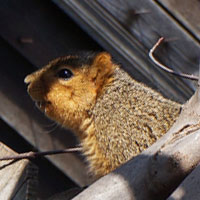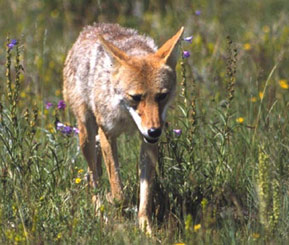Living with Wildlife
Introduction & Species | Interacting with Wildlife | Common Questions
The Department of Natural Resources does not provide removal or capture services for problem wildlife. If necessary, you can contact a qualified Wildlife or Waterfowl Control Operator to deal with problem wildlife (such as causing damage or posing a threat to people or domestic animals). Operators name their own rates and fees.
For more information, contact the Division of Fish & Wildlife at 317-232-4200 or dfw@dnr.IN.gov. If you have questions about permits, view our permits webpage or contact the DNR Permit Coordinator at 317-232-4102 or wildlifepermits@dnr.IN.gov.
Domesticated animals are not regulated by the Indiana Department of Natural Resources.
Don’t request removal of dead animals
The Living with Wildlife page is not intended for collecting information on roadkill nor does it provide the removal of dead animals.
- Contact Indiana Department of Transportation regarding the collection of roadkill on state and federal highways. Local public works or sanitation departments collect wildlife killed on their own streets.
- For removal of dead wildlife from private property, contact a wildlife control operator or remove the dead wildlife yourself. Wear gloves, double-bag small animals in plastic bags or garbage bags, and dispose of them in the trash. In Indiana, other disposal options include burial, incineration, rendering, and composting.
Species-Specific Information
Small Mammal Removal

A resident landowner or tenant can legally capture the following species of wild animals without a permit on the property that he/she owns or rents if the animal is causing or threatening to cause damage to property or is posing a health or safety threat to people or domestic animals.
- Beaver
- Gray Fox
- Red Fox
- Opossum
- Mink
- Muskrat
- Raccoon
- Skunk
- Fox Squirrel
- Gray Squirrel
- Long-tailed Weasel
The landowner/tenant also can designate another person to take that animal for them if:
- The landowner/tenant provides written permission (which must be on the person while taking the animal),
- And no compensation of any kind is given to the person who takes the animal.
- A hunting or trapping license or nuisance wild animal control permit is required to take wild animals on land that you do not own or rent.
Within 24 hours of capture, the person who takes the animal must release it or euthanize it. Animals that are released must be released on land in the county where it was captured. Furthermore, the landowner or property manager must give permission for the release. These nuisance animals cannot be possessed for more than 24 hours and cannot be sold, traded, bartered, or gifted.
Rabbit Removal
Rabbits can only be taken during the legal rabbit season using methods approved for the season and with a hunting license. If you want to trap or shoot rabbits outside of the legal season, you will need a nuisance wild animal control permit from the DNR. Cage traps (wire or wood) that are baited with dried apples or dry ear corn can be effective in capturing cottontail rabbits.
Coyote Removal

Landowners may take coyotes year-round on their private property by trapping or shooting without possessing a wild animal control permit from the DNR and without having a hunting or trapping license. Additionally, a landowner does not need to possess a wild animal control permit from DNR to give another individual written permission to shoot or trap coyotes on the landowner’s property. However, any person taking coyotes on someone else’s property must have a valid hunting or trapping license and, if the take happens outside the regulated coyote season, have written permission from the landowner. Please note that any firearm, archery, or air rifle equipment used for coyote removal may be used only in accordance with local ordinances.
Individuals may also get help with coyote conflicts by contracting with a wildlife control operator.
Bats
The best way to keep bats out of your house is to keep up with the maintenance of your home. Normal wear and tear can cause gaps and cracks in masonry or siding, loose soffits and chimney caps, and more. Maintaining the exterior of your home can greatly reduce opportunities for bats to enter. Bats can get inside holes as small as a half-inch. Also, watch for damage caused by other wildlife. For example, squirrels and raccoons may create an entry point that a bat may enter if the damage is not repaired.
If bats must be removed, it is recommended to evict them in spring or autumn to limit trapping young bats inside and to identify entrance points on buildings and structures. First, identify where the bats are entering your structure by enjoying a nice sunset outside. Within an hour of the sun setting, bats should start to emerge. Make note of where they are leaving the structure to investigate during daylight. Next, follow up with eviction. This is typically done using one-way, funnel-shaped exclusion devices that allow bats to leave but not return.
In Indiana, an individual person may take up to five individual bats within a 24-hour period from a dwelling (i.e., residence or place of work) if the bat constitutes a demonstrable but nonimmediate threat to human safety without a permit. Of course, any take should be done in a humane manner. Please report any bats taken to our sick or dead wildlife reporting tool. Injured or sick bats can be given to a permitted wildlife rehabilitator at the rehabilitator's discretion. Do not pick up a bat with bare hands. If a person has been bitten or scratched by a bat, contact a medical professional as soon as possible and have the bat tested for rabies.
For other circumstances and larger bat evictions, a person must possess a permit or contract with a wildlife control operator.
Other Small Mammal Removal
The species listed below can be captured or killed year-round without a permit or hunting or trapping license from the DNR, and there are no limits to the number of these species that can be taken. Local ordinances must be followed.
- Groundhogs
- Mice
- Moles
- Common (Norway) Rats
- Shrews
- Voles
- Red squirrels
Birds
The following species of birds can be taken without a permit if the birds are committing or about to commit depredations upon ornamental or shade trees, agricultural crops, livestock, or wildlife, or are concentrated in numbers and in a manner that constitutes a health hazard or nuisance as provided under 50 CFR 16 (federal law). Be sure to check local ordinances prior to using pyrotechnics or firearms.
- Brewer’s Blackbirds
- Red-winged Blackbirds
- Brown-headed Cowbirds
- Crows
- Common Grackles
The following can be taken without a permit at any time. Be sure to check local ordinances prior to using pyrotechnics or firearms.
- Monk parakeets
- Rock (feral) pigeons (not including homing pigeons)
- House sparrows
- European starlings
Mute Swans
A resident landowner or tenant can legally capture a mute swan on the property that he/she owns or rents if the animal is causing or threatening to cause damage to property or posing a health or safety threat to people or domestic animals.* Within 24 hours of capture, the person who takes the animal must release it or euthanize it. These animals cannot be possessed for more than 24 hours and cannot be sold, traded, bartered, or gifted. Learn more about mute swans and their management.
*In circumstances where mute swans are residents of a community or a lake association, a wild animal control permit will need to be obtained.
More information
Mammals
- Bats
- Beaver
- Bobcat
- Chipmunk
- Cottontail Rabbit
- Coyote
- Eastern Mole
- Feral / Wild Hog
- Fox Squirrel
- Gray Squirrel
- Groundhog (Woodchuck)
- Muskrat
- Raccoon
- Red Fox
- River Otter
- Striped Skunk
- Opossum
- White-tailed Deer
Birds
Reptiles
Helpful links
- Canada Goose Egg and Nest Destruction Permit
- Canada Goose Management
- Deer Management
- District Wildlife Biologists
- Hunting and Trapping Information
- Orphaned & Injured Wildlife
- Permit Information
- Permitted Wildlife Rehabilitators
- Methods for Managing Human-Deer Conflicts
- Waterfowl Control Operators
- Wildlife Control Operators
- Sick or Dead Wildlife Reporting
